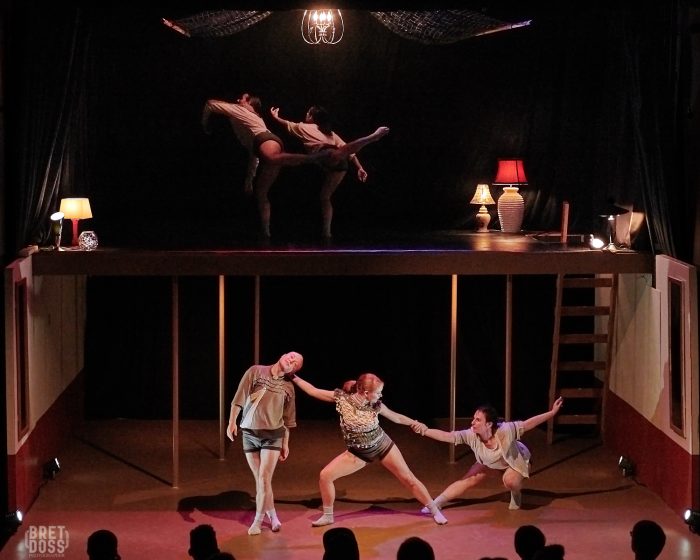Photo: Bret Doss Photography
By Leslie Holleran
In no uncertain terms, “What is Home an Obscure Kingdom an Opera Buffa It’s You Always You,” was as dense as its title suggests. Created by Christin Call for Coriolis Dance, Northwest Film Forum presented the ambitious, three hour-long artistic project last weekend, July 27-28.
Quadruple-threat Christin Call co-directs Seattle-based Coriolis Dance with choreographer Natascha Greenwalt. Call is filmmaker, dancemaker, poet and visual artist.
The work began in the lobby of the Film Forum with audience members taking in the “Home is You” museum. The program provided a context for this elaborate installation that made use of the entire lobby, as well as a small room upstairs: “When an anciently prescient object is unearthed, your neighborhood clamors to set up a temporary museum to house the objects and surrounding artifacts found on the site.” In other words, demolition – a commonplace occurrence in Seattle these days — has uncovered artifacts you really need to see!
As the audience milled about the lobby, a series of dance films played in an adjacent screening room. I ducked in here while awaiting my turn to join a museum tour. When patrons checked in upon entering the lobby, they were given a bracelet which determined which tour group to join.
The tour was “hands-free” according to the docents, requiring me to tuck my notebook into my bag. The docents led the groups upstairs one at a time. We were instructed to form a circle inside the small room, where a diaphanous, circular curtain hung from the ceiling. We were inside that as well.
Moments later, two performers, a man and a woman dressed in red and gold costumes, entered. As they circled inside the circle, they shared imaginary objects with the tour group. As one dancer held the object between my ear and shoulder, I wanted to believe it was a large seashell – the kind you can hold up to your ear and listen to the sea. But, it could have been a pillow or a rolled-up blanket. In any event, some kind of an artifact.
After the tour, I went to see more of the dance films until the performance began. The characters were intriguing. I really wanted to see all of the films from beginning to end, but the structure of the show didn’t afford that opportunity. Pretty soon, the performance on the mainstage was about to begin.
Ultimately, my experience with the series of films left me wondering: Where does it begin? Where does it end? The answer I came up with was: it begins when you start watching and ends when you stop. It’s kind of like being given a book, starting on one random page and needing to leave it before you get to the end.
It was a disjointed experience. But maybe that was part of the point? Home can be a disquieting place too, in spite of its romantic image. Thinking of issues around housing in Seattle, there’s affordabililty (or generally speaking, lack thereof), eviction, and homelessness, etc. (The homeless in Seattle now number over 8,000.) These thorny issues informed the show and was one of the reasons the woman sitting next to me during the performance had come.
The second part of “What is Home…” was a theatrical dance performance with a cast of seven. The two docents from the “Home is You” museum, Faye played by Lauren Hlubny and Puck by Daniel Christensen, became the narrators of a story involving five different characters. They were: Mak (Ana Puzycki), Spence (Elby Brosch), Allison (Stacy Brenner), Camille (Melissa Sanderson), and Jacky (Madeline Gregor). The musical score was an arrangement by Call of ten different works.
The story that was being told here “with devised elements from Shakespeare’s ‘A Midsummer Night’s Dream’, ‘The Taming of the Shrew,’ and ‘King Henry’” very much eluded me, including the narration by the docents. Then, try as I might to find meaning in the movement, I couldn’t. That said, the movement was beautiful and technically well-executed. I enjoyed the balletic vocabulary put in service of a contemporary work.
In the end though, I was left wanting a stronger relationship between the theatrical performance and the overall question, “What is home?,” that I had found in the first half of the show. The stage production had gone over my head. I could appreciate the dancing and acting on a visceral, if not metaphorical, level.
